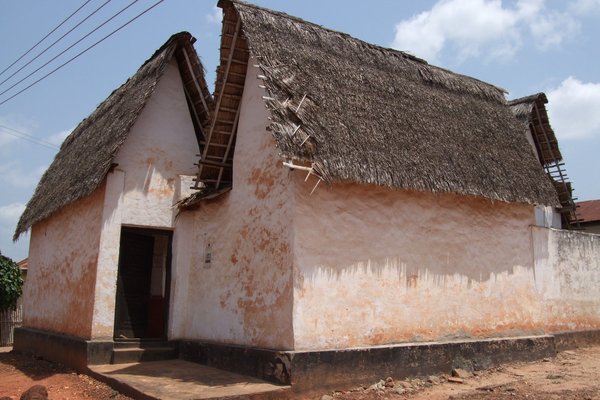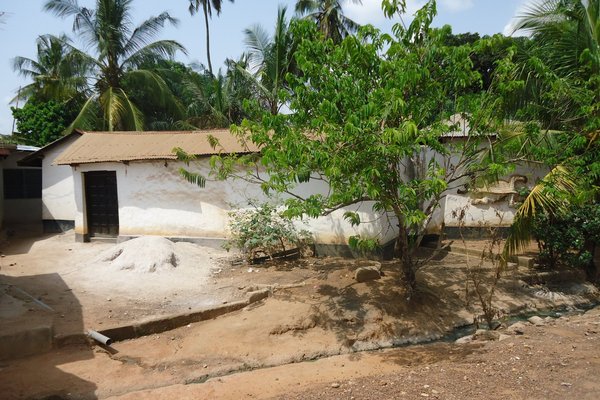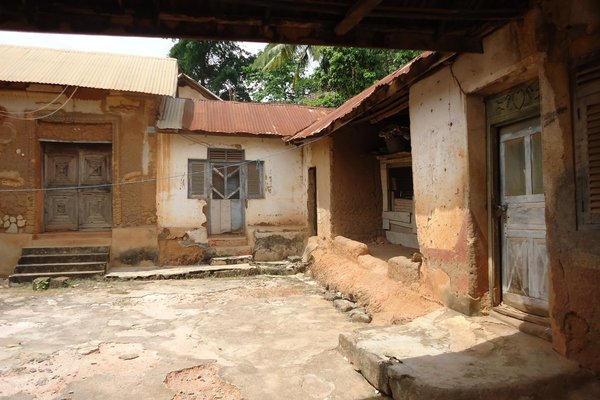Ghana
Asante Traditional Buildings
The Asante Traditional Buildings are the only surviving examples of traditional Asante architecture.
They are shrines/fetish houses decorated with symbolic bas-reliefs. The buildings traditionally have steep thatched roofs on top of a timber framework filled up with clay. Each building consists of four rooms around a quadrangular courtyard. Some of the enlisted buildings still have priests, some don't.
Community Perspective: it has taken a lot of research to find out which buildings are part of this WHS as it lacks an official map; the opinion at the moment is that there are 10 of them, but not all coordinates and names are known. Els and Solivagant both visited Besease shrine, the easiest to reach from Kumasi. Jarek additionally covered Aduko Jachie and Kentikrono in his review.
Site Info
Official Information
- Full Name
- Asante Traditional Buildings (ID: 35)
- Country
- Ghana
- Status
-
Inscribed 1980
Site history
History of Asante Traditional Buildings
- 1980: Inscribed
- Inscribed
- 1979: Deferred
- Bureau - More info wanted
- Type
- Cultural
- Criteria
- v
Links
- UNESCO
- whc.unesco.org
- Official
-
- ghanamuseums.org — Ghana Museums & Monuments Board
- Related
-
- unesdoc.unesco.org — Nomination file by Ghana
- en.wikipedia.org — Wiki on the Ashanti Empire
- international.icomos.org — Case study on conservation of fetish house of Asawase
All Links
UNESCO.org
- whc.unesco.org — whc.unesco.org/
Official Website
- ghanamuseums.org — Ghana Museums & Monuments Board
Forum Discussion
- worldheritagesite.org — Asante Traditional Buildings Locations
Related Resources
- unesdoc.unesco.org — Nomination file by Ghana
- en.wikipedia.org — Wiki on the Ashanti Empire
- international.icomos.org — Case study on conservation of fetish house of Asawase
Community Information
- Community Category
- Archaeological site: Civilizations of Sub-Saharan Africa
Travel Information
Recent Connections
-
No Map
-
African Kingdoms
Ashanti Empire (1670 - 1957)See en.wik…
-
World Monuments Watch (past)
2022See www.wmf.org
Connections of Asante Traditional Buildings
- Trivia
-
-
Swan songs
Ghana 1980
-
- History
-
-
African Kingdoms
Ashanti Empire (1670 - 1957)See en.wikipedia.org
-
- Ecology
-
-
Turtles and tortoises
Besease Shrine has a resident tortoise, which is said to be a fetish
-
- Architecture
- World Heritage Process
-
-
Inscribed on a single criterion only
v. to be an outstanding example of a traditional human settlement, land-use, or sea-use which is representative of a culture (or cultures), or human interaction with the environment especially when it has become vulnerable under the impact of irreversible change -
Incorrect UNESCO 'Number of locations'
No of locations not clear. We know that between 10 and 13 buildings were inscribed. Whilst some may be "adjacent" to and therefore potentially in the same "location" as another, others are widely scattered around or many kms from Kumasi and therefore must be separate "locations" -
No Map
-
- Religion and Belief
-
-
Living indigenous religions
"They represent all that remains of the traditional shrine houses (Abosomfie) of the Ashanti people, each of which was traditionally regarded as the spiritual home of a particular Obosum, a minor deity who could mediate between a mortal being and the supreme god Nyame" see
-
- WHS on Other Lists
- Timeline
-
-
Built in the 19th Century
"There exists today only a small number of the traditional structures, habitats of man and gods, of which the majority are less than 100 years old" (AB eval). The Besease Shrine was built c1850
-
- Visiting conditions
-
-
Unusual Entry Requirements or Restrictions
"Women are not allowed inside the shrine during their menstrual period" - from a study paper on the Beasase Shrine
-
News
No news.
Recent Visitors
Visitors of Asante Traditional Buildings
- Adrian Turtschi
- Afshin Iranpour
- alicemears
- Ali Zingstra
- A. Mehmet Haksever
- Ask Gudmundsen
- Bill Maurmann
- Boj
- Bram de Bruin
- David Aaronson
- Don Irwin
- Els Slots
- Iain Jackson
- Janos
- Jarek Pokrzywnicki
- Jon Opol
- La Concy
- Little Lauren Travels
- Loic Pedras
- Luis Filipe Gaspar
- Michael Novins
- Mikko
- Morodhi
- Philipp Leu
- Pink Bunny
- Randi Thomsen
- Reza
- Solivagant
- Stanislaw Warwas
- Szucs Tamas
- Thomas Buechler
- Thomas van der Walt
- Timothy C Easton
- Vanessa Buechler
- Weecheng
Community Reviews
Show full reviews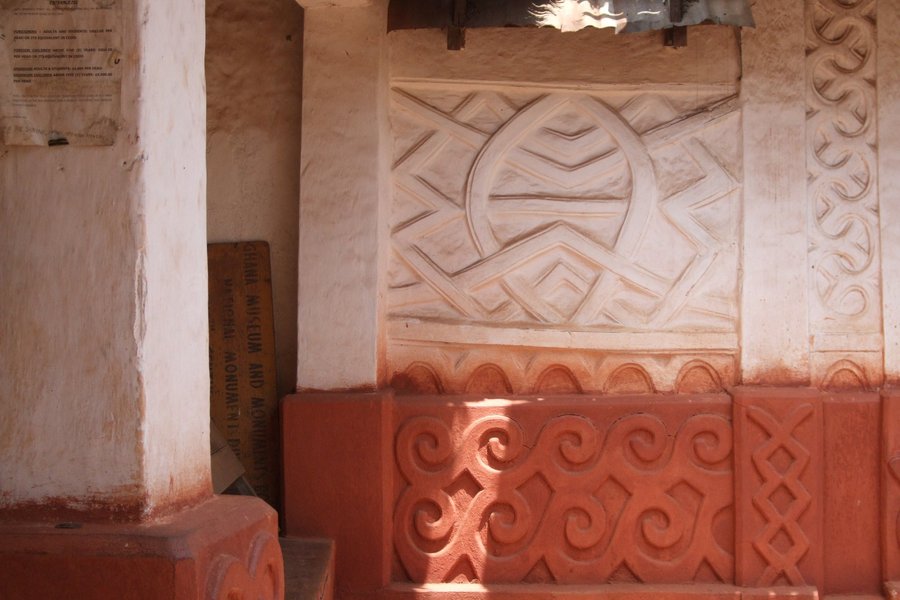
I booked a tour with a local company, Ashanti African Tours, to spend four days in Ghana, visiting the forts and the Asante traditional buildings as well as the Akwasidae Festival, a traditional Asante festival that happens once every six weeks. I was too focused on visas and anti-malarials and a snow storm to closely check the itinerary, which just had an afternoon visiting the site. I was disappointed to learn that only the shrine at Ejisu-Besease had been included. I asked that more be added and also visited Adako-Jackie, which is nearby. I would be specific on any tour and say you want to visit multiple of the shrines. Although I usually have a 30% rule — e.g., have to see at least 30% of the components of a site — I am going to mark this one off, as I did the best I could and I already compromised my rule with the Stecci.
As to the buildings, they are shrines built in the traditional Asante style, often in the 1800s to early 1900s. Due to the wars with the British, there are only around ten such buildings remaining. In many cases, there have been shrines on the sites for hundreds of years. This he shrines typically have four buildings around an open courtyard and have decorated walls and thatched roofs. Some of the thatched roofs are being replaced by metal ones to better protect the buildings and lower maintenance costs. The shrine at Adako-Jachie was under …
Keep reading 0 comments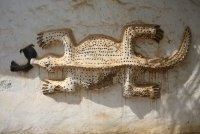
Visited March 2014, the easiest shrine to get is Ejisu Besease - in fact located in Besease village (there is public transport from Kumasi), the only shrine that is well known (to locals) as well as promoted (Ghanaian Tourist Board - Kumasi Branch), other places are more difficult to be visited.
While in Besease it is possible to visit 3 other shrines that are located quite close. Aduko Jachie is located just north of main Kumasi - Accra road (Bradt guide shows exact location), there are no plates nor any other marks of the village. The shrine is located in the northern part of the village (unnoficial entrance fee is 15 Cedi quite a lot comparing to 4 Cedi in Besease). The whole building looks quite usual from the outside (just like surrounding other houses), courtyards preserves some Asante ornaments - most of them in poor condition. In official whc.unesco.org webiste it was mistakingly named Adarko Jachie.
More close to Kumasi lies Kentikrono, some 5-6 km from Aduko Jachie, also just nort of the main Kumasi - Accra road. The shrine lies in eastern part of village - ask for Asante shrine or Ghana Museum as the locals call it. Some ornaments are placed outside the building (photo above), more are in the courtyard. Unfortunately whan I was there the building was locked (as locals say the guy responsible for the shrine works in Kumasi). In official whc.unesco.org webiste it was mistakingly named Kentinkrono.
Another shrine is located some 5 …
Keep reading 0 comments
I visited the shrine at Besease, which bears testimony to the once impressive Ashanti Kingdom, as you can see on the photos showcased there. I think the stories its walls tell are what gives this site its meaning and authenticity mark, as the site itself might be overlooked by some tourists. It's unfortunate though that UNESCO has not given attention to other sites around the area which I believe, even if they have post-colonial influences, could also be considered the last remains of a culture that is slowly degrading. I went to Aburi to take a look at lake Bosomtwi, and it was then when I really felt the declaration should encompass a wider range of cultural assets. Further efforts should be made to protect the small towns around Kumasi too. In conclusion, I think focusing on the shrines as living proof of Ashanti's people traditions and values is a little reductive to be honest, and real measures to enlarge the declaration or nominate more sites should be taken.
Keep reading 0 comments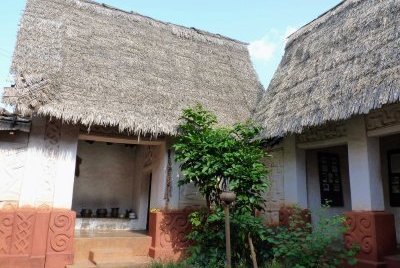
We visited the Ashanti Shrine at Besease in Nov 2010. Our research (the Nomination File, the Web and the Bradt Guide) indicated that it was the easiest and best of the 10 (or 13?) shrines to visit from Kumasi and I have no reason to doubt this judgement. We traveled by coach from Accra to Kumasi and, as we were very short of time, arranged to be dropped off at the village of Ejisu on the main road about 20kms short of Kumasi. The shrine is signed from the main road road and is set back around 200 yards to the left facing Kumasi.
The old man who is "guardian" (the same guy as in Els's review and photo) and can open up isn't there all the time and will probably have to be fetched from the village somewhere but locals in shops/stalls nearby the shrine seem to know where to get him. We were warned that he might be "some (African??) time" but in our case they found him in around 10 minutes. He expects a tip on top of the entrance of course so he has good reason to come!
An hour is enough to see the shrine and have the old man "doing" his grass skirt show (said skirt is hanging ready on one of the walls!). As Els says, the old guy doesn't speak English but a local school-boy teamed up with us to explain the libation ceremonies etc which were not really covered …
Keep reading 0 comments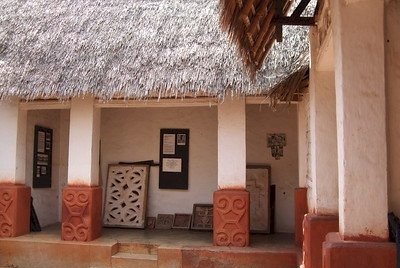
During my stay in Kumasi, I hired a driver for the day and we went on a tour across the surrounding countryside. There are a couple of interesting craft villages to visit. There you can see Kente-weaving (in Adanwomase) or the dyeing of Adinkra-cloth (in Ntonso). To satisfy one of my WHS goals of this trip, we also included the Besease shrine. It is located near Ejisu, 20 km east of Kumasi.
The building is whitewashed on the outside and includes a very steep thatched roof. It originally dates from ca. 1850, but it was fully restored in 1998. There’s a 2 cedi’s entrance fee, collected by a caretaker who didn’t seem to speak English but clearly loves guests and being photographed. After the restoration, the building was turned into some kind of museum. There are photographic displays on its walls of other traditional buildings, and good explanations in English.
The whole compound is quite small, so it is kind of an underwhelming experience. You’ll have to try hard to spend more than 10 minutes inside. Don’t overlook the fetishes that lie around in the courtyard: there’s a tortoise for example, and strings of sheep and goats’ vertebrae (from sacrificed animals). Women who can’t get pregnant are said to still visit the shrine. The shrines obviously are part of a living tradition that now almost has gone. However, they have been included in the World Heritage List for their vernacular architecture. A wonderful feature is the symbols carved …
Keep reading 0 comments
